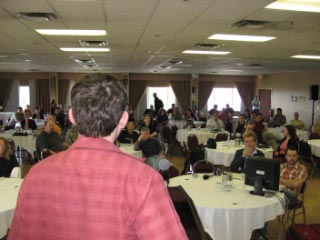Tod Maffin entertained and educated the Podcasters Across Borders attendees with his From Idea to Air presentation.
 If you haven’t seen Tod give one of his keynotes or workshops, you absolutely have to. The best presenter bar none.
If you haven’t seen Tod give one of his keynotes or workshops, you absolutely have to. The best presenter bar none.
I’m not going to be able to do justice to Tod’s full presentation. He’s much better than I make him sound. And sound is the operative word. Tod doesn’t just offer sage advice in an entertaining way. He peppers his presentation with sound clips that make the points he wants to convey.
So, how do you tell great stories?
Off the top. If you want to tell good audio stories, don’t be predictable. Don’t follow a formula. Don’t be boring.
Start with an idea. And remember, that YOU are the content. Look around you for story ideas. Ask family. Ask friends. Never throw away clips. The bloopers and off-story clips may let you approach the story from a different, more playful angle.
Revisit old stories. Epilogues to past stories can be poignant and compelling.
Look for inspiration in wallpaper – the stuff all around us. The commonplace. Those things that are part of our routine and that we take for granted. Like ordering a cup of coffee leads to a story on oversized servings. Why the close buttons on elevators never work.
Use comparisons to create images in your listener’s mind. Like …a 20 oz. drink? You can buy 20 oz. baseball bats.
Take your recorder everywhere. You never know when you will encounter a great opportunity to capture a story as it occurs. And things captured as they occur have an emotion and an unpolihsed genuineness.
Don’t overedit. Sometimes the raw tape – with the pauses, the sighs, the silence – can be much more arresting than any edit or voiceover.
You can structure you story around several different devices.
The universal truth: It throws something into relief that strikes a chord with us and causes us to nod unconsciously. You can lead into this with the phrase, “There’s something about…” This sets up the listener to listen for something more profound.
The anecdote and reflection: This is the basic essence of storytelling. Bringing meaning to what you’ve just heard. Tell a little of the story. Reflect. Tell a bit more. Reflect. Dip in and out of the story. The audeince will follow throughout.
 Sixty second scenes: Actively listening requires the brain to compose images. Allow time for this to happen. Provide audible “audio on-reamps” – music, an audio effect or even silence – to signal to the listener that they should be ready for a change of scene.
Sixty second scenes: Actively listening requires the brain to compose images. Allow time for this to happen. Provide audible “audio on-reamps” – music, an audio effect or even silence – to signal to the listener that they should be ready for a change of scene.
Emotional charges: Modulate the emotions through the story. Unrelenting seriousness is unlikely to sustain an audience’s attention in the way that a story that alternates poignancy with a lighter mood to bring balance.
Scoring: Use music. But don’t use music to comment on the story. It can be hackneyed (Pink Floyd’s Money in a story about the rich). Or it can actually pull the listener out of the images they have created in their mind.
There are three critical values for a compelling character.
- Your protagonist must be on a proactive quest toward a goal (love, redemption, money)
- Something is preventing him or her from achieving that goal (“force of antagonism”)
- The protagonist is risking something to achieve the goal. Risk is the secret sauce in making people care about a character.
 The quest should have not be linear. There should be progress followed by setbacks followed by progress. Drama and comedy rest in the “Gap” between what a character expects to achieve and what they actually achieve. This gap provides reason for the protagonist to attempt a different approach to achieve their objective. And at each turn, the risk increases.
The quest should have not be linear. There should be progress followed by setbacks followed by progress. Drama and comedy rest in the “Gap” between what a character expects to achieve and what they actually achieve. This gap provides reason for the protagonist to attempt a different approach to achieve their objective. And at each turn, the risk increases.
If life would go back to normal if the character failed to achieve her objective, then the story is not worth telling. It fails the risk test.
Tod presented much more on how to do this. But I’m not going to cover that here. You simply have to see Tod live to get the rest. And trust me. It’s the best presentation of this material you’ll ever see.
